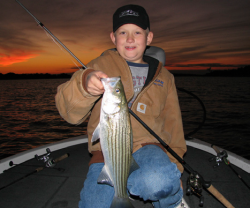by Brett Graham
Fishing on Lake Texoma took on a new twist when the lake got its first stock of Striped Bass. A species known for its voracious appetite and extreme power, stripers, or rockfish or linesiders or rollers or squidhounds or greenheads or, if you are of an ichthyologic bent, Morone sasatilis, are saltwater fish that spawn in fresh water.
Striper Migration
Ninety percent of the Atlantic population started life in Chesapeake Bay, but when biologists discovered that stripers could live and thrive in the fresh water of inland lakes, something new began to show up on angler’s hooks. With its deep, open water and high salinity, Lake Texoma proved a perfect home for stripers, and while they have been stocked in many lakes around the country, Texoma is one of only seven lakes in the United States where the striper population reproduces naturally. Because of this, Texoma quickly became known as one of the best striper fishing lakes in the country.
Bait and Switch
From the 1970s to the mid 1980’s, the striper fishing on Texoma was almost exclusively with artificial baits, then in 1984, fishermen from Arkansas and the East Coast began showing up with their custom bait tanks. They hauled live bait—shad, both thread fin and gizzard— all the way to North Texas, and that style of fishing took off, and with the live bait, came the practice of big group fishing.
Live bait fishing is popular because it works. It is common enough to see six or eight boats tied together, with twelve rods per boat dropped straight down with live shad, especially during warmer months. Some may argue that the art of the stalk has been lost, but for most fishermen, the near guarantee of success wins out.
That success brought anglers, both experienced and novices, from all across the country to take a crack at Texoma’s unsurpassed action, and they needed guides. By the early 1990s there were over 100 guides working on the lake.
Bait or Lure?
“Are you a lure fisherman or a bait fisherman?” That is the question. There is not much crossover on the lake these days; you are either one, or the other, and that goes for guides as well. There are a few guides who do both, but that requires a more extensive knowledge of striper patterns and bottom structure, so most guides, like the fishermen, stake out the way they best like to fish.

If the fisherman has limited casting skills, or is fishing with young children, then live bait is the best way to go. Even if the fish are biting artificial lures much better than live bait, if you can’t properly present the artificial baits you’ll limit your catch. But if you can get the lure in the right place most of the time, and not cause a ruckus doing it, then the choice of techniques becomes a bit more complicated.
Cold water, 65 degrees and below, produces several variables. One advantage to live bait is scent, but in cold water the scent of live bait is diminished. Fish are cold blooded creatures so their metabolism is determined by water temperature. Cold water causes them to slow down; they are not as active as they are in warm water. This means that the fish are less likely to come to the fishermen, so the fishermen needs to go to the fish.
January, February and March are excellent months for artificial bait. By April, the water is warming, and the fish are returning from the rivers to spawn. They are hungry and ready to eat. This is a transition month, and both live bait and artificial lures will be effective.
October, November and December are the top months for stripers, with incredible topwater and schooling action. This time of year is typically when the biggest fish are caught. Acton can get frantic and almost everyone on the water will be hauling them in.
Lake Texoma can provide the angler with great fishing 12 months of the year. All lakes tend to be cycles; there will be periods where fishing is excellent, and times when it is less so, but right now, Texoma striper fishing is on top of the curve, so make sure you get on the water while the getting is good. No fisherman likes to hear, “You know, you should have been here yesterday.”
This article was written by avid fisherman Brett Graham, and appeared in the Winter 2006 issue of Texoma Living!.
